
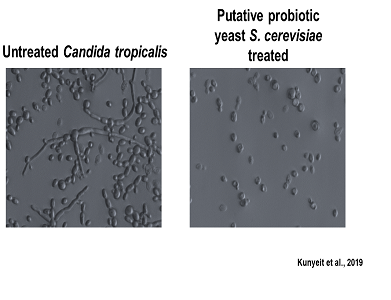
कैंडिडा संक्रमण, सबसे प्रमुख एटियालाजिक एजेंट है जो सभी के स्वास्थ्य के लिए एक बड़ा खतरा बन गया है, विशेष रूप से ऐसे लोगों के लिए जिनके शरीर में चिकित्सा साधन प्रत्यारोपित किए गए हैं। रोग प्रतिरोधक क्षमता की हानि रोगज़नक़ को पाचन तंत्र के सबम्यूकोसल ऊतक में घुसने और आंतरिक अंगों में फैलाती है, जिससे जानलेवा प्रणालीगत संक्रमण उत्पन्न होते हैं। ये आम नॉन-एल्बिकन्स, कैंडिडा से जुड़े संक्रमण, विभिन्न किण्वित खाद्य पदार्थों में मौजूद खमीर और लोगों के दैनिक आहार में अनिवार्य खमीर-आधारित प्रोबायोटिक्स, का विकल्प के रूप से मुकाबला करने के लिए विशेष रूप से आवश्यक हैं क्योंकि ये प्राकृतिक रूप से अधिकांश एंटीबायोटिक दवाओं के प्रतिरोधक हैं, जिससे ये संपूर्ण एंटीबायोटिक प्रक्रिया के दौरान बैक्टीरियल माइक्रोफ्लोरा के आपस में मिल जाने पर जठरांत्र मार्ग में जीवित रहते हैं।
इस शोध में कैंडिडा ट्रॉपिकलिस, कैंडिडा क्रुसी, कैंडिडा ग्लबराटा, कैंडिडा पैराप्सिलोसिस और कैंडिडा ऑरिस जैसे पांच नॉन-एल्बिकंस कैंडिडा स्ट्रेंस के बायोफिल्म के आसंजन और विकास को रोकने के लिए दो यीस्ट, सैक्रोमाइसेस सेरेविसिया (स्ट्रेन KTP) और इस्सैचेंकिया ऑसीडेंटलिस (ApC) का प्रभाव दिखाया गया है। इन शोधों से पता चलता है कि खाद्य स्रोतों से प्राप्त खमीर उभरते रोगजनक कैंडिडा जीवों के खिलाफ एंटिफंगल चिकित्सा के प्रभावकारी विकल्प के रूप में काम कर सकते हैं। इसके परिणाम पारंपरिक रोगाणुरोधी चिकित्सा को प्रोबायोटिक रोगाणुओं से लाभकारी रोगाणुरोधी उपचार में परिवर्तित करने की वर्तमान प्रवृत्ति पर प्रभाव डालेंगे।


सीएसआईआर-केंद्रीय खाद्य प्रौद्योगिक अनुसंधान संस्थान के शोधकर्ताओं ने β-मैनो-ऑलिगोसेकेराइड्स (β-MOS), प्रीबायोटिक घटक के रूप में पौधे से प्राप्त फाइबर और प्रोबायोटिक्स के रूप में लैक्टोबैसिलस प्लांटेरम तथा लैक्टोबैसिलस फरमेंटम का उपयोग करके एक कम वसा वाली सिनबायोटिक आइसक्रीम विकसित किया है। इसमें β-MOS का उपयोग किया गया क्योंकि यह कठोर गैस्ट्रो-इंटस्टाइनल परिस्थितियों के तहत लाभकारी लैक्टोबैसिली की संख्या बढ़ाता है और नए, अभिनव और स्वस्थ खाद्य पदार्थ तैयार करने के कई अवसर प्रदान करता है।
आइसक्रीम मिक्स में तुलना करने के लिए दूध का पाउडर, चीनी, वसा, स्टेबलाइजर, इमल्सीफायर, वैनिलिन, दूध के साथ या बिना दूध के प्रीबायोटिक β-MOS / फ्रक्टो ऑलिगोसेकेराइड्स (FOS) मिले रहते हैं। सामान्य वसा वाली और कम वसा वाली आइसक्रीम जैसे विभिन्न आइसक्रीम फॉर्मूलेशन तैयार किए गए हैं, जिनमें प्रोबायोटिक लैक्टोबैसिलस एसपीपी, FOS और β-MOS के साथ पूरक मिले होते हैं। प्रोबायोटिक प्रकृति को परिरक्षित करते हुए भंडारण के दौरान उसकी जांच के करने के लिए आइसक्रीम मिक्स को -200ºC पर भंडारित किया जाता है। कम वसा वाले आइसक्रीम को नियंत्रित करने की तुलना में कम वसा वाले सिनबायोटिक आइसक्रीम में, कन्सिसटेंसी इंडेक्स, प्रवाह और चिपचिपाहट अधिक पाया गया।
एक नकली गैस्ट्रोइंटेस्टाइनल परिस्थिति में, नए प्रकार के आइसक्रीम का आकलन किया गया और देखा कि β-MOS की उपस्थिति से उस आइसक्रीम में लैक्टोबैसिलस प्लांटारम बढ़ गया है साथ ही नियंत्रणों की तुलना में गैस्ट्रिक और आंतों के तनाव के तहत के साथ-साथ लैक्टोबैसिलस फेरमेंटम के अस्तित्व को बढ़ाया।

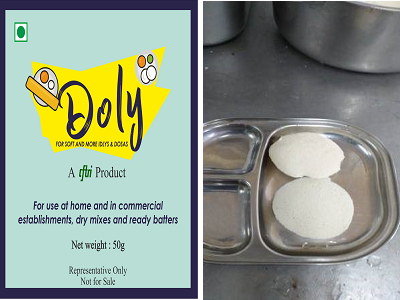
सीएफटीआरआई ने उपयोग के लिए तैयार शेल्फ स्थायी इडली/डोसा बैटर की प्रौद्योगिकियों का खुदरा पैकों में व्यवसायीकरण कर दिया है। इडली और डोसा के बढ़ते वैश्विक बाजार में इसकी व्यावसायिक सफलता को ध्यान में रखते हुए, सीएफटीआरआई ने अब डॉलीमिक्स उत्पाद विकसित किया है जो कि नरम और अधिक संख्या में इडली तैयार करने के लिए तुरंत उपलब्ध रहता है। डॉलीमिक्स में अनाज से तैयार सामग्री मिलायी गयी है और इसे नरम इडली और डोसा बनाने के लिए डिज़ाइन किया गया है। इससे इडली की संख्या 20% तक बढ़ जाती है और सांभर इसमें आसानी से अवशोषित हो जाता है। इस मिश्रण को पीसने की प्रक्रिया पूरी होने के बाद डाला जाना चाहिए और इसमें चावल और उड़द का किसी भी अनुपात में इस्तेमाल किया जा सकता है। डॉलीमिक्स का उपयोग घर पर, व्यावसायिक (होटल) प्रतिष्ठानों में और सूखे मिश्रणों में भी किया जा सकता है। इसका विक्रय B2B या B2C के रूप में किया जा सकता है। बाजार में इस तरह का और कोई उत्पाद उपलब्ध नहीं है।
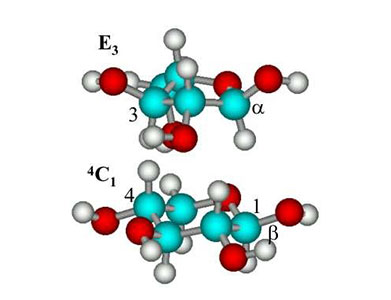
अरेबीनॉक्सिलैन्स (AXs) नॉन-स्टार्च पॉलीसेकेराइड का एक प्रमुख समूह है जो मुख्य रूप से अनाज के चोकर में मौजूद होता है। वे अत्यधिक विभाजित होते हैं और अरेबिनोस में साइड चेन के साथ डी-ज़ाइलोपाइरानोज से जुड़े β-1,4 रीढ़ की हड्डी से बने होते हैं। AX के कई कार्यात्मक और पोषण संबंधी स्वास्थ्य लाभ हैं। AX दोनों पानी निकालने योग्य (WE-AX) और पानी अन-एक्सट्रैक्टेबल (WU-AX) पॉलीसेकेराइड हैं। WE-AX कोशिका की दीवार की सतह से शिथिल रूप से बंधे होते हैं। WU-AX को फेनोलिक एसिड, प्रोटीन और सेल्यूलोज कॉम्प्लेक्स के साथ सहसंयोजक और गैर-सहसंयोजक बातचीत द्वारा सेल की दीवार में बनाए रखा जाता है। एंटीऑक्सिडेंट से भरपूर एस्टर लिंक्ड AX (फेरुलिक एसिड) पेट के कैंसर, मधुमेह और एथेरोस्क्लेरोसिस के लक्षणों को कम करने में मदद करता है। यह इम्युनोमोड्यूलेशन में भी मदद करता है और वजन प्रबंधन का समर्थन करता है। सीएसआईआर-सीएफटीआरआई में गेहूं और चावल की भूसी से फेनोलिक एसिड एएक्स की तैयारी के लिए प्रक्रिया विकास को मानकीकृत किया गया है। न्यूट्रीबार, सिंके हुए खाद्य पदार्थ और पेय पदार्थ जैसे उत्पाद जिसमें AX प्रचुर मात्रा में है, उत्पादन क्रम में हैं। भारत में गेहूं और चावल मिलिंग उद्योग हैं, अत: कच्चा माल यानी AX को अलग करने के लिए अनाज की भूसी प्रचुर मात्रा में उपलब्ध है। AX आधारित कार्यात्मक खाद्य उत्पादों और न्यूट्रास्यूटिकल्स में विश्व स्तर पर विशेष पोषण और रोगनिरोधी पोषण उद्योगों में जबरदस्त व्यावसायिक क्षमता है। AX और AX युक्त खाद्य पदार्थों का उत्पादन बढ़ाने से भारत के लिए बड़े पैमाने पर किफायती उपयोगी खाद्य उपलब्ध कराना संभव होगा।
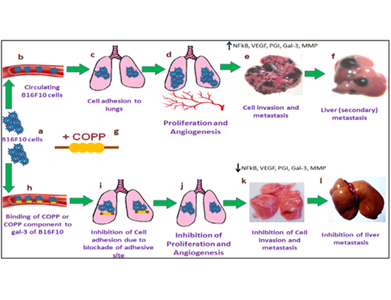
Metastasis is one of the complex steps in cancer. It involves multiple stages such as cell adhesion, cell invasion, angiogenesis, continuous proliferation, inhibition of cell death, etc., ultimately responsible for dysregulated cell growth and formation of aggregated tumors. Complex multi-step events during metastasis are the result of an interplay of multiple molecules such as galectin-3, a triggering molecule for cascades of activities such as cell adhesion, angiogenesis, inhibition of cell death, matrix metalloproteinases etc., that help tumor cells to invade into newer organs. Vascular endothelial growth factors to support angiogenesis to support angiogenic growth and hence enhance the survivability, NFĸB, a transcription factor for continuous proliferation, PGI – Phosphoglucoisomerase, which isomerases Glucose to fructose and fructose which can be utilized faster by cancer cells.
We had shown previously the role of dietary pectic polysaccharides in inhibiting galectin-3 mediated agglutination that appear to be a critical event during metastasis including cancer cell-normal cell interaction, cancer cell proliferation, cell adhesion etc., in in vitro models. In the current study, we report the role of corn pectic polysaccharide in inhibiting metastasis in vivo and modulation of cancer specific molecules. B16F10 induced lung metastasis has been used as a model to study metastasis and molecules responsible for metastasis. In Scheme – 1 it is indicated that B16F10 melanoma cells grown in vitro were injected through the tail vein of the animal and cells are known to harbor in the lung due to cell adhesion and could see the induction of lung tumors expressing tumor markers. Treatment with Corn Pectic Polysaccharide (COPP), inhibited cell adhesion, proliferation, angiogenesis and metastasis. ~ 72% inhibition of tumor nodules were observed compared to that of the untreated animal group.
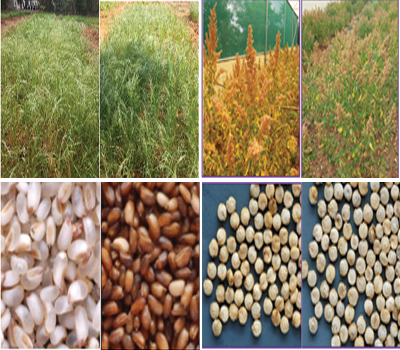
With an ever-expanding global population, unprecedented climatic changes and increased use of pesticides there is an urgent need to make the most out of the available arable lands to strategically address these issues. In this direction CFTRI has ventured into identifying crops of high nutritive value twhich can grow on relatively dry lands with scanty water availability and low maintenance. Towards this, we have introduced 3 new crops that come under the "Superfoods" category, viz., Chia, Quinoa and Teff, in India along with the agrotechnologies. Also pure line selection, two lines of Chia that are high yielding and white in colour.
Chia is a Mexican crop and the highest known vegetarian source of the essential omega 3 fatty acid, alpha linolenic acid, which is critical for brain and heart health. Quinoa is a Bolivian pseudocereal crop with seeds rich in high quality protein that could be a good substitute for rice, especially for the diabetics. Teff is from Ethiopia and is the tiniest seed packed with maximum nutrition. It is a powerhouse of protein and minerals, especially rich in calcium. All three crops are of 120 days duration, require very little water and easy to maintain, giving a yield of 300-400 Kg per acre.
CSIR-CFTRI provided the superfood seeds free to the farmers along with the agrotechnology has helped the farmers create a Farmers Producers Organization (FPOs) to support supply-chain logistics and marketing. This has helped the farmers to make improved economic status.

New global non-alcohol, non-LAB based functional fungal fermented foods, such as Nilamadana, Kaulath, Shamak and Trilambija, that utilize India’s underutilized cereals and grains are created. A process has been standardized to prepare ready-to-use idli/dosa batter in retail packs and being offered as a free technology by CFTRI for interested entrepreneurs. Starter cultures, which impart known flavor and olfactory qualities, for wine production have been developed and an array of fruit wines are standardized for value addition.
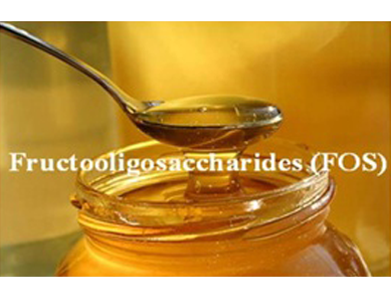
Prebiotics are functional food components that improves human health by inducing the growth of healthy microorganisms. A process for the production of FOS is developed. Diversity, genomics and probiotic functionality of probiotic bacteria like Lactobacillus spp. and bifidobacteria are being assessed. Molecular evidences for antibiotic resistance in enterococci and lactobacilli is explored. Novel biopreservatives from food bacteria are being evaluated. Focus is also on understanding the molecular interactions between phytochemicals and gut microbiota.
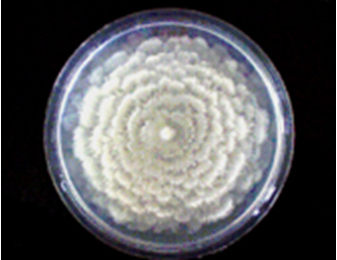
Microbes as source for specialty lipids: Several oleaginous fungi have been investigated for the production of PUFAs specially for gamma linolenic acid, arachidonic acid and its derivatives such as EPA and DHA, which are having many medicinal properties and large industrial applications.
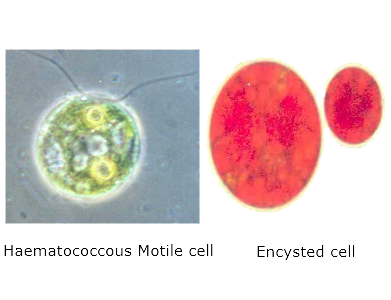
Haematococcus is a green alga and has two distinct phases in its life cycle - Motile growth phase and Immotile caroteniod accumulating encysted stage. Lutein is the major carotenoid in the growth phase. Haematococcus accumulates astaxanthin (a ketocarotenoid) under stress conditions. Astaxanthin and its esters constitute 85-90% of total carotenoids in Haematococcus with astaxanthin mono ester being the major one (~70%) followed by diester (~20-25%) and free astaxanthin (4-5%). Astaxanthin has high antioxidant property and plays a role in immune enhancement and prevention of age related macular degeneration. It is used as pigmentation source in farmed salmon and trout. Astaxanthin is approved by FDA-USA and some European countries for its use in humans as dietary food supplement. Process conditions for growth and carotenoid accumulation have been optimized at lab scale. Downstream process for astaxanthin extraction was developed and bioactivity of astaxanthin and its esters in terms of antiulcer and skin cancer preventive properties have been shown in animal models. Scale-up process will be taken up with industry /entrepreneur collaboration.
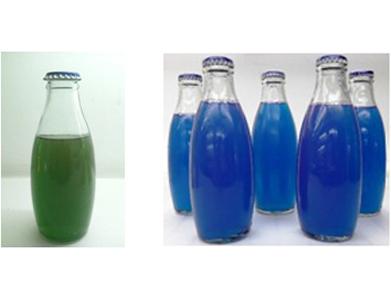
The microalga Spirulina and the Phycocyanin, a natural blue pigment derived from Spirulina have been notified as nutraceuticals by the FSSAI, Govt. of India in ‘The Gazette of India, 2016’. However, the food applications of Spirulina, has remained limited due to the sensorial challenges posed by the dried Spirulina powder. CSIR-CFTRI has developed the RTS Beverages based on Spirulina and Phycocyanin to widen the food applications of Spirulina and to provide the nutraceutical benefits to consumers.
The RTS – Whole Spirulina Beverage is prepared with the ‘Whole Spirulina’ to harness all the nutritional benefits of Spirulina. The beverage contains nutritionally important pigments such as natural blue coloured Nutraceutical, Phycocyanin, Carotenoids and Chlorophyll. The Spirulina also contributes, proteins, B group of vitamins and minerals to the beverage.
The RTS-Phycocyanin beverage is prepared with the Phycocyanin, a natural blue coloured Nutraceutical pigment derived from Spirulina. The Phycocyanin is known as an excellent antioxidant and immune system booster.
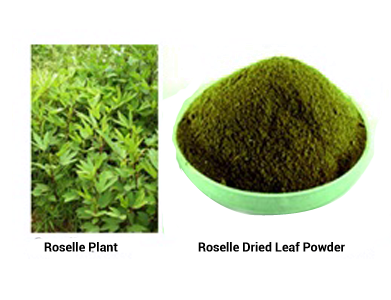
Based on phytochemical profiling and antioxidant assays, a process for preparation of a green leafy vegetable i.e. Hibiscus cannabinus / H. sabdrariffa (roselle) leafy powder has been developed and the same can be used in food fortification in view of its rich nutritional and nutraceutical potential. The foliage is especially rich in ascorbic acid and iron content. In view of its physical and sensory properties, this leaf powder can be used to fortify various food products like chutney powders, soup mixes, energy bars etc., and also to garnish processed foods.

हाइबिस्कस सैडबारिफा (रोसेल) के कैलिक्स से एंथोसायनिन (लाल) युक्त अर्क प्राप्त करने के लिए एक विधि तैयार की गयी है और इसकी एंटीऑक्सीडेंट क्षमता भी स्थापित की गई है। इसे कैंडी आदि बनाने में प्राकृतिक खाद्य रंग के रूप में इस्तेमाल किया जा सकता है।
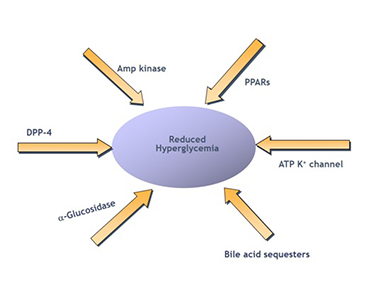
भोजन न केवल एक जीव के लिए ऊर्जा और बिल्डिंग ब्लॉक्स प्रदान करता है, भोजन में मौजूद बायोएक्टिव अणु हृदय रोग, मोटापा, मधुमेह और ऑस्टियोपोरोसिस जैसी बीमारियों को रोकने में मदद कर सकते हैं, जो असंतुलित आहार के कारण काफी हद तक होता है। इसे खाद्य-व्युत्पन्न न्यूट्रास्युटिकल्स द्वारा रोका जा सकता है और/या इसमें सुधार किया जा सकता है। यहां, हमारा ध्यान ऑस्टियोपोरोसिस, मधुमेह और संबंधित विकारों जैसे कुछ रोग स्थितियों को रोकने/कम करने के लिए खाद्य व्युत्पन्न अणुओं की पहचान करना और उन्हें चिह्नित करना है। टाइप II डायबिटीज (T2D) पर विशेष ध्यान दिया गया है। T2D के लिए कई दवाएं उपलब्ध हैं और लक्ष्य प्रोटीन जिससे वे बांधते हैं और उनकी क्रिया के तंत्र को भी जाना जाता है। परियोजना का मुख्य फोकस खाद्य स्रोतों से अणुओं की पहचान करना है जो इन तंत्रों को सकारात्मक रूप से विनियमित कर सकते हैं जिससे साइड इफेक्ट, दवा की खुराक और अन्य टी 2 डी संबंधित जटिलताओं को कम किया जा सके। उत्पन्न ज्ञान का उपयोग T2D के प्रबंधन के लिए कार्यात्मक खाद्य पदार्थों के विकास के लिए भी किया जा सकता है।
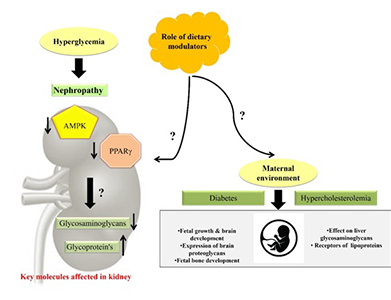
गर्भावस्था और जीवन के प्रारंभिक विकास के चरणों के दौरान अनुभव की जाने वाली पोषण की स्थिति और वातावरण कई बीमारियों के व्याधिनिदान में महत्वपूर्ण भूमिका निभाता है। साक्ष्य बताते हैं कि न केवल वृद्धि और विकास, बल्कि मधुमेह, ऑस्टियोपोरोसिस, यकृत फाइब्रोसिस आदि कुछ ऐसी बीमारियां हैं जिन्हें क्रमबद्ध किया गया है। विशेष रूप से, मातृ पोषण वयस्क होने पर अल्पपोषण की मात्रा और जीवन शैली अव्यवस्था के विकास के निर्धारण में महत्वपूर्ण प्रतीत होता है। इसके अलावा, जीव के वृद्धि और विकास में शामिल कुछ प्रमुख अणु जैसे कि ग्लाइकोसामिनोग्लाइकेन्स मातृ आहार के साथ-साथ विभिन्न पैथोफिजियोलॉजिकल स्थितियों के दौरान गर्भाशय में रीमॉडेलिंग से गुजरते हैं। हमारा उद्देश्य यह समझना है कि मातृ आहार बीमारियों के विकास को कैसे प्रभावित करता है और इन्हें नियंत्रित करने वाले अंतर्निहित तंत्र का पता लगाना है, जिसमें चयापचय और एपिजेनेटिक तंत्र शामिल हैं।
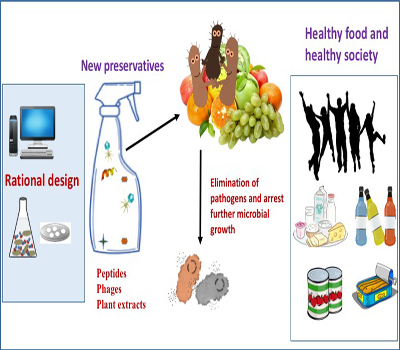
सूक्ष्मजीव दो प्रमुख स्थितियों के कारक एजेंट हैं - खाद्य का खराब होना और खाद्य जनित रोग, जो खाद्य विज्ञान के लिए अत्यंत प्रासंगिक हैं। फसल की कटाई के साथ-साथ मध्यम से लंबी अवधि तक भंडारण के दौरान होने वाले खाद्य के भारी नुकसान के प्रमुख कारणों में से एक है खाद्य का खराब होना। दूसरी ओर, खाद्य जनित रोग सार्वजनिक स्वास्थ्य के लिए, विशेष रूप से विकासशील देशों के लिए प्रमुख चिंता का विषय हैं। सूक्ष्मजीवों के कुछ समूहों द्वारा खाद्य के सूक्ष्मजीवी संदूषण से खाद्य की बनावट, गंध/स्वाद में बदलाव होगा या खाद्य की शेल्फ लाइफ कम हो जाएगी या उसमें विषाक्त पदार्थों का स्राव होगा जिससे खाद्य अत्यधिक विषाक्त हो जाता है। इसलिए, खाद्य के खराब/विशाक्त होने के लिए जिम्मेदार बैक्टीरिया के माध्यम से क्रियाविधिक निरीक्षण पर ज़ोर दिया जा रहा है प्रमुख जोर मुख्य प्रोटीन के कार्य में यंत्रवत अंतर्दृष्टि प्राप्त करना है और बैक्टीरिया से मार्ग जो भोजन के खराब होने/विषाक्तता का कारण बनते हैं। इस प्रयास की दिशा में एक अन्य दृष्टिकोण बैक्टीरियोफेज द्वारा खाद्य रोगजनकों का मुकाबला करने के लिए रणनीति विकसित करना है। कुल मिलाकर, हमारे प्रयास बुनियादी अनुसंधान से प्राप्त विचारों को खाद्य पदार्थों के खराब होने को कम करने/रोकने के लिए विकासशील अणुओं की दिशा में अनुवाद करने के लिए तैयार हैं और इस तरह खाद्य पदार्थों के शेल्फ जीवन को बढ़ाते हैं, और/या बेहतर सार्वजनिक स्वास्थ्य के लिए खाद्य विषाक्तता को नियंत्रित करते हैं। अतः मुख्य प्रोटीनों के कार्यों और भोजन को खराब/विषाक्त बनानेवाले बैक्टीरिया संबंधी क्रियाविधिपरक परिज्ञान प्राप्त करने पर अधिक जोर दिया जाता है।
